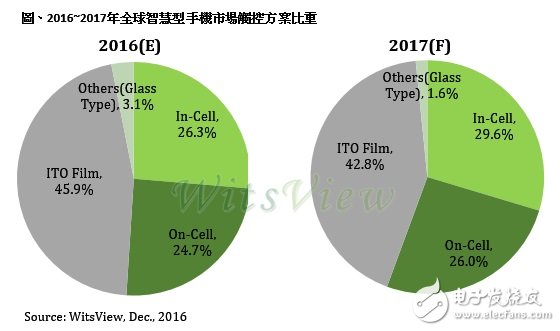According to a recent study by TrendForce Optoelectronics Research (WitsView), In-Cell touch panels accounted for the overall smartphone market in 2017, driven by the availability of TDDI (Touch and Display Driver IntegraTIon) IC products and accelerated introduction of panel manufacturers. The proportion rose to 29.6%. On-Cell touch panels will benefit from the demand for AMOLED panels, and the share of the overall smartphone market will increase to 26% in 2017. In contrast, the Out-Cell touch panel weight is estimated to fall to 42.8%.

WisView senior research manager Fan Bozhen pointed out that panel makers are interested in In-Cell products. The main reason is that the integration of In-Cell panels can enhance the added value of products, provide complete product solutions to customers, and help simplify traditional mobile phones. Product assembly is an ecologically complex supply chain system. In the In-Cell product design, with TDDI IC, you can save space on some material costs such as FPC soft board.

Fan Bozhen said that although the current price of TDDI IC is still high, there are more and more IC manufacturers available, including Synopsys and Duntai Technology, which are the first to enter, and other Taiwanese IC design manufacturers who have successively launched products. It is expected that the price of TDDI IC will decline in 2017, and there will be an opportunity for In-Cell's cost to move closer to Out-Cell cost and accelerate overall demand growth. WitsView estimates that the proportion of In-Cell products equipped with TDDI IC will be In 2016, 6% grew to 12% in 2017.
After the Apple iPhone 5 series officially introduced the In-Cell touch solution, the In-Cell touch panel became a must-have for high-end phones. However, the In-Cell products of the non-Ping camp are still subject to the TDDI IC development progress is not as expected, so in addition to Apple, only a few brands of high-end models use In-Cell touch solutions. In 2016, with the TDDI products of several major IC manufacturers in place, the panel factory officially launched In-Cell products equipped with TDDI ICs, and the market visibility began to increase significantly.
Fan Bozhen pointed out that Apple will introduce AMOLED panels in 2017, which may reduce the demand for In-Cell. However, the penetration of In-Cell touch panels in the overall smartphones is expected to continue under the expansion of In-Cell products. Upgrade.
On the other hand, while most of the panel makers are moving resources to the development of In-Cell, it will limit the growth of On-Cell TFT-LCD capacity in 2017. However, thanks to the high demand of AMOLED panels, Driven by the growth of On-Cell AMOLED shipments, the penetration rate of smartphone On-Cell touch panels is still expected to climb in 2017.
Fan Bozhen further stated that with the increasing capacity of AMOLED and LTPS in the future, panel makers will become more active in promoting integrated products such as On-Cell and In-Cell; in contrast, traditionally, Out-Cell is the dominant Touch manufacturers must face strategic adjustments, shift to the middle and low-end market segments or face more intense price competition in exchange for living space.
Guangzhou Yunge Tianhong Electronic Technology Co., Ltd , http://www.e-cigaretteyfactory.com